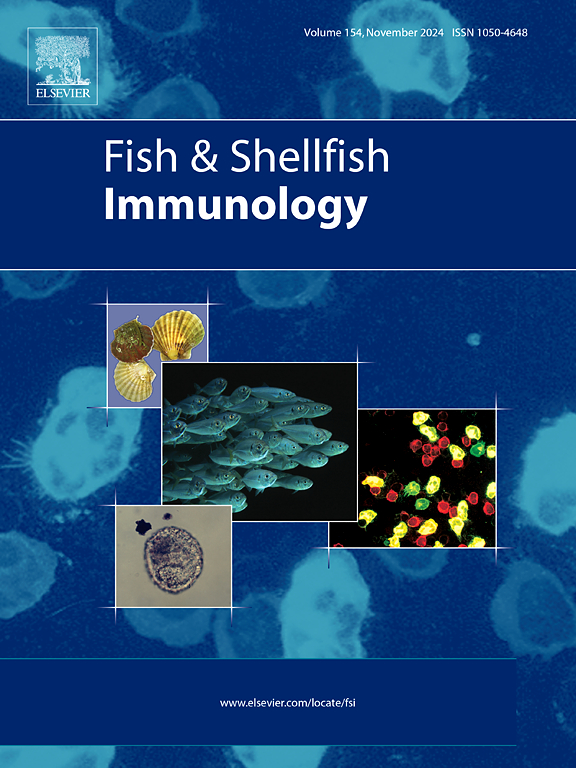CgCREM调节太平洋牡蛎长牡蛎的血细胞增殖和炎症因子表达。
IF 3.9
2区 农林科学
Q1 FISHERIES
引用次数: 0
摘要
cAMP应答元件调节剂(CREM)是cAMP信号下游的一种调节转录因子,在调节免疫细胞的增殖和分化中发挥转录激活或转录抑制的作用。本研究从长牡蛎中鉴定出具有保守pKID结构域和BRLZ结构域的CgCREM。研究发现,CgCREM mRNA转录本在胚胎阶段高度表达,特别是在囊胚和trochophre中。在成年牡蛎中,CgCREM在血淋巴中的表达量最高,是肝胰腺中的157.3倍(p < 0.05)。免疫荧光分析发现,CgCREM主要定位于牡蛎血细胞细胞核,尤其是半粒细胞。脾弧菌刺激后,造血细胞中CgCREM mRNA的表达在3、6、12 h均显著上调。脾弧菌刺激后,CgCREM与下游基因CgRunx1和cgcd -45的结合显著增强,分别是对照组的10.43倍(p < 0.001)和3.16倍(p < 0.01)。通过RNAi敲低CgCREM表达后,脾v刺激后血细胞中细胞增殖相关因子(CgRunx1、CgBMP7、cggat3)和细胞周期调节因子(CgCDC-45、CgCDK-2、CgCDC-6)的表达水平显著降低。同时,CgCREM敲除牡蛎中EdU+阳性血细胞、粒细胞和半粒细胞比例显著降低,炎症因子(CgIL17-1、CgIL17-2和CgIL17-3)表达下调。以上结果提示,CgCREM作为一种转录因子参与调节牡蛎C. gigas血细胞增殖相关基因和炎症因子的表达,突出了CREM在调节软体动物免疫应答中的关键作用。本文章由计算机程序翻译,如有差异,请以英文原文为准。
CgCREM regulates haemocyte proliferation and inflammatory factor expression in the Pacific oyster Crassostrea gigas
The cAMP response element modulator (CREM) is a regulatory transcription factor downstream of cAMP signaling, functioning either as a transcriptional activator or repressor in regulating the proliferation and differentiation of immune cells. In the present study, CgCREM with a conserved pKID domain and a BRLZ domain was identified from Pacific oyster Crassostrea gigas. The mRNA transcripts of CgCREM were found to be highly expressed in embryonic stages, especially in the blastula and trochophore. In adult oyster, CgCREM exhibited the highest expression level in haemolymph, which was 157.3-fold (p < 0.05) of that in hepatopancreas. By immunofluorescence analysis, CgCREM was found to mainly localize in the nucleus of oyster haemocytes, especially in semi-granulocytes. After Vibrio splendidus stimulation, the mRNA expression of CgCREM in haemocytes was significantly up-regulated at 3, 6, and 12 h. The binding of CgCREM to the promotes of downstream CgRunx1 and CgCDC-45 was significantly enhanced after V. splendidus stimulation, which was 10.43-fold (p < 0.001) and 3.16-fold (p < 0.01) of that in control group, respectively. After the expression of CgCREM was knocked-down by RNAi, the expression levels of cell proliferation-related factors (CgRunx1, CgBMP7 and CgGATA-3), and cell cycle regulatory factors (CgCDC-45, CgCDK-2 and CgCDC-6) in haemocytes were significantly reduced after V. splendidus stimulation. Simultaneously, the ratio of EdU+ positive haemocytes, granulocytes and semi-granulocytes were significantly reduced in CgCREM knocked-down oysters, concomitent with the down-regulated expressions of inflammatory factors (CgIL17-1, CgIL17-2 and CgIL17-3). All these results collectively suggested that CgCREM, as a transcription factor, was involved in regulating expressions of haemocyte proliferation related genes and inflammatory factors in oyster C. gigas, highlighting the pivotal role of CREM in regulating immune response in mollusks.
求助全文
通过发布文献求助,成功后即可免费获取论文全文。
去求助
来源期刊

Fish & shellfish immunology
农林科学-海洋与淡水生物学
CiteScore
7.50
自引率
19.10%
发文量
750
审稿时长
68 days
期刊介绍:
Fish and Shellfish Immunology rapidly publishes high-quality, peer-refereed contributions in the expanding fields of fish and shellfish immunology. It presents studies on the basic mechanisms of both the specific and non-specific defense systems, the cells, tissues, and humoral factors involved, their dependence on environmental and intrinsic factors, response to pathogens, response to vaccination, and applied studies on the development of specific vaccines for use in the aquaculture industry.
 求助内容:
求助内容: 应助结果提醒方式:
应助结果提醒方式:


